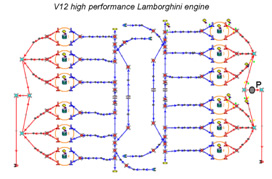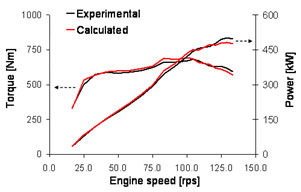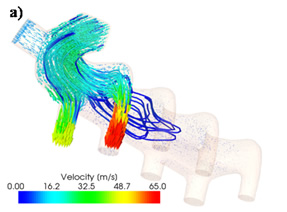Wave motion in complex pipe systems
Over the last two decades the activity of the research group has distinguished itself for its strengths in the 1D thermo-fluid dynamic modeling of internal combustion engines. The main result of such an activity is the development of an in-house code, named GASDYN, which has been successfully applied to the study and optimization of SI, Diesel and HCCI engines.
 The fluid dynamic numerical model is based on the conservation equations for one-dimensional, unsteady, compressible, reacting flows in ducts with variable cross-section. The shock-capturing
numerical methods adopted are symmetric finite difference schemes with second order accuracy with the addition of flux-limiting techniques. The typical component encountered in the air management system can be fully modeled in the 1D environment, resorting to characteristic-based boundary
conditions: multi-pipe junctions, pressure losses, plenums, intercoolers, turbines and compressors, EGR and waste-gate valves, silencers, three-way catalysts, diesel particulate filters and other
after-treatment devices such as DOC, DeNOx and SCR catalysts.
The fluid dynamic numerical model is based on the conservation equations for one-dimensional, unsteady, compressible, reacting flows in ducts with variable cross-section. The shock-capturing
numerical methods adopted are symmetric finite difference schemes with second order accuracy with the addition of flux-limiting techniques. The typical component encountered in the air management system can be fully modeled in the 1D environment, resorting to characteristic-based boundary
conditions: multi-pipe junctions, pressure losses, plenums, intercoolers, turbines and compressors, EGR and waste-gate valves, silencers, three-way catalysts, diesel particulate filters and other
after-treatment devices such as DOC, DeNOx and SCR catalysts.
 The 1D fluid dynamic models have been successfully applied in a wide number of research and
industrial applications to evaluate the engine performances, for model assessment purposes but also to help the design stage of new engines. Validation has been conducted either on the basis of
global analysis torque, volumetric efficiency, cycle averaged pressure and temperature along the pipe system) either by comparing high frequency measured pressure traces with computed values
in numerous location of the intake and exhaust systems.
The 1D fluid dynamic models have been successfully applied in a wide number of research and
industrial applications to evaluate the engine performances, for model assessment purposes but also to help the design stage of new engines. Validation has been conducted either on the basis of
global analysis torque, volumetric efficiency, cycle averaged pressure and temperature along the pipe system) either by comparing high frequency measured pressure traces with computed values
in numerous location of the intake and exhaust systems.
A user friendly graphical interface, GasdynPre, allows to input any type of engine geometry in a time efficient way.

 Recent works have highlighted the importance of resorting to 3D CFD codes to asses a more precise prediction of the wave motion when complex geometries are addressed. For instance,
multi-pipe junctions, air boxes or other geometries in which it is important to capture the flow distribution, may
require the adoption of a CFD analysis. However, if the CFD brings additional information which
are not captured by 1D models, it is also true that the required computational time increases considerably. For these reasons, an hybrid 1D/3D fluid dynamic model, relying on a Godunov type
Riemann solver at the interface between the two domains, was developed to achieve a complete integration at the time step level. The Euler equations have been integrated to simulate the unsteady
flows in the intake and exhaust manifold, resorting to 3D grids with different levels of refinement.
Recent works have highlighted the importance of resorting to 3D CFD codes to asses a more precise prediction of the wave motion when complex geometries are addressed. For instance,
multi-pipe junctions, air boxes or other geometries in which it is important to capture the flow distribution, may
require the adoption of a CFD analysis. However, if the CFD brings additional information which
are not captured by 1D models, it is also true that the required computational time increases considerably. For these reasons, an hybrid 1D/3D fluid dynamic model, relying on a Godunov type
Riemann solver at the interface between the two domains, was developed to achieve a complete integration at the time step level. The Euler equations have been integrated to simulate the unsteady
flows in the intake and exhaust manifold, resorting to 3D grids with different levels of refinement.
Download movies with examples of 1D-3D coupling:
» junction.gif
» plenum.gif
Publications:
1 - Montenegro, G., Onorati, A., Piscaglia, F., D'Errico, G., "Integrated 1D-MultiD Fluid Dynamic Models for the Simulation of I.C.E. Intake and Exhaust Systems",
SAE Technical Paper 2007-01-0495, 2007.
2 - Montenegro, G., Onorati, A., "Modeling of Silencers for I.C. Engine Intake and Exhaust Systems by means of an Integrated 1D-multiD Approach", SAE Int. J. Engines 1(1): 466-479, 2009.








